Cleaning, sanitation and hygiene are often the most inexpensive and effective way to reduce the need for antimicrobials in health systems worldwide ~ Review on AMR taskforce
Importance of cleaning in Infection Control
Poor hygiene and Inadequate cleaning lead to disease and unnecessary deaths. The latest report from the AMR taskforce emphasises that prevention is cheaper and far more effective than cure. An increased dependence on curing with medications rather than prevention with hygiene has led to increased antibacterial resistance. It is no longer the case that this is only relevant to developing countries. Globally, sanitation has never been more important than it is today.
Apart from the financial and organisational disruption to an organisation, inadequate infection control will have devastating consequences to human health.
Effective sanitation helps to prevent the spread of infection and to fight against the rise of drug-resistant microorganisms. Any intervention that stops the spread of infection within healthcare facilities will reduce the amount of disease and the number of deaths. As well as this, effective hygiene is crucial in the fight against antimicrobial resistance.
Common Infections affecting healthcare providers
Viruses
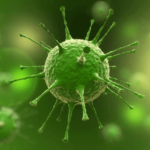
Image Source: New Health Advisor
Viruses are responsible for diseases ranging from the common cold through to norovirus, measles, herpes, Ebola, influenza, HIV and rabies. With diameters ranging from 20 to 300 nanometres, viruses are among the smallest pathogens known to exist, a nanometre is one billionth of a metre. Viruses reproduce after infecting a host by inserting its own RNA or DNA and disrupting function within the host as infected cells now produce proteins using genetic material from the virus.
Influenza virus
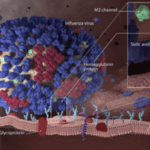
Graphical representation Courtesy of CDC (Centers for Disease Control and Prevention)
Influenza virus causes the contagious disease, influenza (flu). The disease primarily affects the respiratory system and symptoms can be severe, potentially fatal in vulnerable members of the population. Influenza symptoms also include fever, cough, muscle aches, headaches and fatigue. As the virus mutates it is important for those at risk to receive a new vaccine each year. Predictions indicate that the predominant influenza virus for the winter of 2016-2017 will be two influenza A viruses: H1N1, H3N2 as well as at least one of the influenza B viruses.
Norovirus
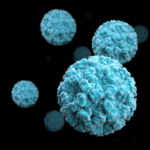
Image Source: CDC (Centers for Disease Control and Prevention)
Highly contagious, this virus shows no discrimination and can affect anybody. Infection routes can be via infected people, contaminated food or even contaminated surfaces. Norovirus will cause painful inflammation of the stomach and/or intestines leading to nausea, sickness and diarrhoea causing dehydration. The symptoms can be serious in vulnerable adults or children. Norovirus is now the leading cause of illness from contaminated food in the U.S. The arrival of norovirus within a care institution or hospital will usually precede a rapid spread throughout the organisation.
Clostridium difficile (C. diff) bacteria
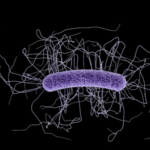
Image Source: CDC (Centers for Disease Control and Prevention)
Another infection that is causing a problem in healthcare organisations. This pathogenic bacteria commonly affects people within healthcare settings, people with a compromised immune system, people taking antibiotics long term and the elderly. The symptoms include severe diarrhoea, headaches and dehydration which can develop into serious complications in some patients.
Escherichia coli (E.coli) bacteria
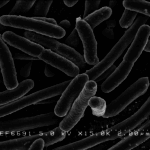
Image Source: CDC (Centers for Disease Control and Prevention)
E. coli bacteria usually live harmlessly, and helpfully, in the gut. Some E. coli strains are pathogenic and capable of causing illness. E. coli is spread by eating contaminated food and poor hygiene practices via contact with people who are infected with the organism. It causes diarrhoea, cramps, fever and potentially kidney failure.
Infection Control Statistics
From 2013 to 2016, Public Health England data shows an encouraging decrease in MRSA bacteraemia of 19.9% but from the period of April 2016 to June 2016 the number of cases remained constant. At the same time, E. coli bacteraemia showed a 29% increase. Professional infection control cleaning will diminish the risks posed by viruses and other pathogens
Infection Control Cleaning
Virus sanitation plays a crucial role in infection control. Professional cleaning combined with a programme of education and reinforcement for all members of the organisation could drastically reduce the risk of disease caused by pathogens like MRSA, Norovirus and E. coli. Effective infection control cleaning is a crucial line of defence. The cleaning must be thorough, regular and precise and carried out with a scientific understanding of exactly what is required.
The Solution
Ideal Response has been the chosen provider of virus sanitation and infection control cleaning for medical and care organisations since 2001. Our fully qualified technicians provide a professional cleaning service using BioSweep technology. BioSweep is the latest technology to provide effective sterilisation and eradication of surface and airborne contaminants. BioSweep technology provides unparalleled decontamination using photocatalytic oxidation technology to eliminate all harmful pathogens. View our air and surface decontamination service to find more information on our virus sanitation and infection control cleaning service.
The Results
| Pathogen | Treatment Time | Recution (Log) | Reduction as (%) |
| MRSA | 1 hour | 6.67 | 99.999967% |
| MRSA | 4 hours | 6.9 | 99.999969% |
| C.diff. | 5 hours | 5.0 | 99.999% |
| Geobacillus* | 5 hours | 5.48 | 99.99948% |
✓ Sterilisation of area
✓ Destruction of pathogens
✓ Air cleansed and purified
✓ Reduced infection and disease
✓ Protection for up to one year
Do you have any questions regarding Virus Sanitation and Infection Control? Call us today to speak with a member of our team on 01622 926 505



